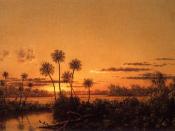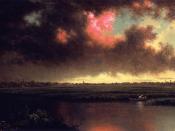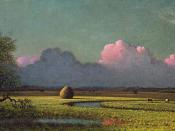In 1883, the romantic artist, Martin Johnson Heade visited Florida. Impressed with St. Augustine, Heade settled there and worked in a studio in the Ponce De Leon Hotel made available to the artist by Henry Flagler, railroad magnate and developer of Florida's east coast. The combination of St. Augustine's Old World atmosphere, tropical vegetation, and serene marshes created the ideal working environment for Heade. Heade's contribution to American nineteenth-century painting is embodied by his study of light, particularly as reflected in painting of sun-dappled fields and marshes (Casson 213). He is admired for his originality and for the subtle atmosphere effects, glorious light and sumptuous warmth of his canvases. The St. Johns River marked with a colorful sky, steady movement, and a quiet mood, is a good example of Heade's mature painting style.
The first visual technique that the artist used in this painting was Heade's brilliant use of light.
The dark greens of the trees and the blackness of the bushes contrast strongly against the atmospheric scattering of sparkling light rays dissolve into cool shades of the evening. The bright tint of the sparkling sun seems to fade slowly as late afternoon wends its way to dusk and dusk to nightfall. In chapter three of my textbook, I read the most interesting theory of light that helped me to better understand the visual elements of art used in this particular painting and every other piece of art that I encounter:
"Light is fascinating stuff. It radiates. It illuminates. It dazzles. It glows. It beckons like a beacon. We speak of the 'light or reason.' We speak of genius as 'brilliance.' Visible light undulates wavelike throughout the universe. It bounces off objects and excites cells in our eyes, enabling us to see. Light is at the very core of the...


